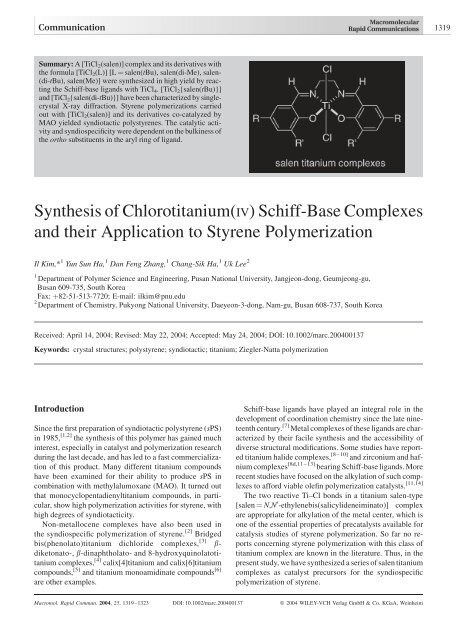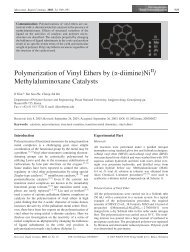Schiff-Base Complexes and their Application to Styrene ...
Schiff-Base Complexes and their Application to Styrene ...
Schiff-Base Complexes and their Application to Styrene ...
Create successful ePaper yourself
Turn your PDF publications into a flip-book with our unique Google optimized e-Paper software.
1320 I. Kim, Y. S. Ha, D. F. Zhang, C. Ha, U. LeeExperimental PartGeneral Methods <strong>and</strong> MaterialsAll reactions were performed under a purified nitrogen atmosphereusing st<strong>and</strong>ard glove-box <strong>and</strong> Schlenk techniques. <strong>Styrene</strong>(from Aldrich) was washed twice with aqueous sodiumhydroxide (5 wt.-%) <strong>and</strong> twice with water, followed by dryingover MgSO 4 <strong>and</strong> distillation over CaH 2 under N 2 atmosphereat reduced pressure. Solvents were dried under nitrogen usingst<strong>and</strong>ard reagents. MAO was obtained from Akzo Chemical asan 8.4 wt.-% <strong>to</strong>tal Al solution in <strong>to</strong>luene. The tetradentatelig<strong>and</strong> salen [1a; N,N 0 -bis(salicylidene)ethylene-1,2-diamine]<strong>and</strong> its derivatives salen(tBu) [1b; N,N 0 -bis(3-tert-butyl-2-hydroxybenzylidene)ethylene-1,2-diamine], salen(di-Me) [1c;N,N 0 -bis(2-hydroxy-3,5-dimethylbenzylidene)ethylene-1,2-diamine], salen(di-tBu) [1d; N,N 0 -bis(3,5-di-tert-butyl-2-hydroxybenzylidene)ethylene-1,2-diamine], salen(Me) [1e;N,N 0 -bis(2-hydroxy-5-methylbenzylidene)ethylene-1,2-diamine]were prepared according <strong>to</strong> a literature procedure. [15]Polymerization of <strong>Styrene</strong>A Schlenk tube (30 mL) with a magnetic stirrer was attached <strong>to</strong>a high-vacuum line <strong>and</strong> then sealed under a nitrogen atmosphere.The required amounts of distilled <strong>to</strong>luene (5 mL),styrene (5 mL), MAO <strong>and</strong> precatalyst (25.6 mmol) werecharged in<strong>to</strong> the dried Schlenk tube in this order under nitrogenflow. The polymerization was carried out at constant temperaturefor 5 h. The reaction was quenched with acidifiedmethanol (5 vol.-% HCl) <strong>and</strong> then precipitated with excessmethanol. The resulting mixture was filtered <strong>and</strong> dried undervacuum at 60 8C. The polymerization yield was determinedgravimetrically. The isolated samples comprised syndiotactic<strong>and</strong> atactic polymers, <strong>and</strong> the atactic part was extracted withrefluxing 2-butanone for 4 h. The atactic polymer was isolatedby vacuum removal of the solvent.Characterization1 H NMR spectra of salen <strong>and</strong> its derivatives were recorded on aVarian Unity Plus 300 spectrometer in CDCl 3 , using tetramethylsilaneas the internal reference. Elemental analysis wascarried out using a Vario EL analyser.The intrinsic viscosity was measured in o-dichlorobenzeneat 135 8C using a modified Ubbhelode viscometer. Theaverage molecular weight was calculated by the followingequation: [16]½ZŠ ¼1:38 10 4 M 0:7vThermal analysis of the hot 2-butanone insoluble polymerwas carried out with a differential scanning calorimeter (DSC,Perkin-Elmer DSC, model: Pyris1) at a heating rate of 10 8C/min under nitrogen atmosphere. Any thermal his<strong>to</strong>ry differencein the polymers was eliminated by first heating the specimen<strong>to</strong> above 280 8C, cooling at 10 8C/min <strong>to</strong> 90 8C, <strong>and</strong> thenrecording the second DSC scan.Syntheses of Titanium <strong>Complexes</strong>[TiCl 2 (salen)] (2a)Literature procedures were employed <strong>to</strong> synthesize titaniumsalen complexes. [17] As an example, [TiCl 2 (salen)] (2a)waspreparedas follows. H 2 salen (0.300 g, 1.12 mmol) in THF was treateddropwise with titanium(IV) chloride (0.212 g, 1.12 mmol)with vigorous stirring. Orange [TiCl 2 (salen)(THF)] precipitatedimmediately from solution. This mixture was thenrefluxed until all of the orange solid had been replaced by thedark red microcrystalline solid [TiCl 2 (salen)]. After removingthe solvent by filtration, the microcrystalline solid was washedwith an ace<strong>to</strong>ne/water mixture (50:50) <strong>and</strong> then with pureace<strong>to</strong>ne. The resulting solid was dried in vacuo. Yield: 75.6%.1 H NMR (300 MHz, CDCl 3 , 293 K): d ¼ 4.26 (s, 4 H), 6.83–7.14 (m, 4 H), 7.46–7.66 (m, 4 H), 8.38 (s, 2 H) ppm.Anal. Calcd for C 16 H 14 Cl 2 N 2 O 2 Ti: C, 49.91; H, 3.66; N,7.27. Found: C, 50.02; H, 3.71; N, 7.24.[TiCl 2 {salen(tBu)}] (2b)Following the above procedures, the crude product was recrystallizedfrom p-xylene <strong>to</strong> yield red rectangular crystalssuitable for X-ray diffraction. Yield: 87.1%.1 H NMR (300 MHz, CDCl 3 , 293 K): d ¼ 1.45 (s, 9 H), 4.15(s, 4 H), 6.93 (t, J ¼ 7.5 Hz, 2 H), 7.30 (dd, J ¼ 7.65, 1.50 Hz,2 H), 7.53 (dd, J ¼ 7.95, 1.5 Hz, 2 H), 8.72 (s, 2 H) ppm.Anal. Calcd for C 24 H 30 Cl 2 N 2 O 2 Ti: C, 57.97; H, 6.08; N,5.63. Found: C, 58.02; H, 6.07; N, 5.61.[TiCl 2 {salen(di-Me)}] (2c)Following the above procedure, the crude product was recrystallizedfrom <strong>to</strong>luene. Yield: 90.3%.1 H NMR (300 MHz, CDCl 3 , 293 K): d ¼ 2.10 (s, 6 H), 2.34(s, 6 H), 3.89 (s, 4 H), 6.43 (s, 2 H), 6.93 (s, 2 H), 7.59 (s, 2 H)ppm.Anal. Calcd for C 20 H 22 Cl 2 N 2 O 2 Ti: C, 54.45; H, 5.03; N,6.35. Found: C, 54.47; H, 5.10; N, 6.37.[TiCl 2 {salen(di-tBu)}] (2d)Following the above procedures, the crude product was recrystallizedfrom <strong>to</strong>luene <strong>to</strong> yield red rectangular crystals suitablefor X-ray diffraction. Yield: 91.5%.1 H NMR (300 MHz, CDCl 3 , 293 K): d ¼ 1.26 (s, 18 H), 1.37(s, 18 H), 4.13 (s, 4 H), 7.19 (s, 2 H), 7.53 (s, 2 H), 8.26 (s, 2 H)ppm.Anal. Calcd. for C 32 H 46 Cl 2 N 2 O 2 Ti: C, 63.06; H, 7.61; N,4.60. Found: C, 62.98; H, 7.67; N, 4.62.[TiCl 2 {salen(Me)}] (2e)Following the above procedure, the crude product was recrystallizedfrom <strong>to</strong>luene. Yield: 83.6%.1 H NMR (300 MHz, CDCl 3 , 293 K): d ¼ 2.28 (s, 6 H), 4.15(s, 4 H), 6.93 (d, J ¼ 8.4 Hz, 2 H), 7.30 (dd, J ¼ 8.4, 2.1 Hz, 2 H),8.23 (s, 2 H) ppm.Anal. Calcd for C 18 H 18 Cl 2 N 2 O 2 Ti: C, 52.33; H, 4.39; N,6.78. Found: C, 52.32; H, 4.37; N, 6.69.Macromol. Rapid Commun. 2004, 25, 1319–1323 www.mrc-journal.de ß 2004 WILEY-VCH Verlag GmbH & Co. KGaA, Weinheim
Synthesis of Chlorotitanium(IV) <strong>Schiff</strong>-<strong>Base</strong> <strong>Complexes</strong> <strong>and</strong> <strong>their</strong> <strong>Application</strong> <strong>to</strong> <strong>Styrene</strong> Polymerization 1321X-ray Crystallographic Studies of <strong>Complexes</strong> 2b <strong>and</strong> 2dThe X-ray analyses of 2b <strong>and</strong> 2d were performed by U. Lee.Details are provided in the Supporting Information.A crystal of 0.63 0.10 0.04 mm 3 for [TiCl 2 {salen(tBu)}](2b) <strong>and</strong> 0.38 0.31 0.13 mm 3 for [TiCl 2 {salen(di-tBu)}](2d) was selected for X-ray data collection. The data werecollected on a STOE STADI4 diffrac<strong>to</strong>meter equipped withMo-Ka radiation (l ¼ 0.71069 Å) using the o 2y scan modeat 298(2) K. The data were corrected for Lorentz <strong>and</strong> polarizationeffects. A numerical absorption correction based on aseries of j scans was applied. All calculations were carried outwith the X-STEP programs package. The structures weresolved by the direct method. All H-a<strong>to</strong>ms bonded <strong>to</strong> C-a<strong>to</strong>mswere included in the structure-fac<strong>to</strong>r calculation at idealizedpositions, <strong>and</strong> were allowed <strong>to</strong> ride on <strong>their</strong> parent a<strong>to</strong>mswith relative isotropic displacement parameters [U iso (H) ¼1.2U eq (C)].Results <strong>and</strong> DiscussionThe chloro complex [TiCl 2 (salen)] has been reported byseveral groups <strong>and</strong> used as a precursor for organometallicderivatives. [7,9,15,17] Moreover, synthetic procedures whichallow the isolation of [TiCl 2 (salen)] (2a in Scheme 1) usingthe same reactants in polar reaction media have beenreported. [18] The derivatives of 2a having the formula[TiCl 2 (L)] [L ¼ salen(tBu) (2b), salen(di-Me) (2c), salen-(di-tBu) (2d), salen(Me) (2e)] were successfully synthesizedin high yield.The molecular structures of 2b <strong>and</strong> 2d showing thea<strong>to</strong>mic numbering scheme are shown in Figure 1. aScheme 1. Synthesis of the <strong>Schiff</strong>-base lig<strong>and</strong>s <strong>and</strong> <strong>their</strong> chlorotitanium(IV)complexes.aCCDC-230214 (2b) <strong>and</strong> -230215 (2d) contain the supplementarycrystallographic data for this paper. These data can beobtained free of charge at www.ccdc.cam.ac.uk/conts/retrieving.htmlor from the Cambridge Crystallographic Data Centre,12 Union Road, Cambridge CB2 1EZ, UK [Fax: þ44 1223336033; Email: deposit@ccdc.cam.ac.uk].Figure 1. Molecular structures of [TiCl 2 {salen(tBu)}] (2b) <strong>and</strong>[TiCl 2 {salen(di-tBu)}] (2d). Displacement ellipsoids are drawnat the 30% probability level <strong>and</strong> H a<strong>to</strong>ms have been omitted forclarity.Although the titanium centre is pseudo-octahedral, considerabledis<strong>to</strong>rtion is evident, with metal-centered bondangles varying from 75.8(4)8 [N(1)–Ti–N(2)] <strong>to</strong> 95.5(3)8[Cl(2)–Ti–O(1)] for 2b <strong>and</strong> from 75.3(2)8 [N(1)–Ti–N(2)]<strong>to</strong> 94.8(2)8 [Cl(1)–Ti–O(2)9 for 2d.The equa<strong>to</strong>rial plane of the octahedron is provided by theN 2 O 2 core of the <strong>Schiff</strong>-base lig<strong>and</strong>. The apices are occupiedby the two chlorine a<strong>to</strong>ms, which are skewed from theequa<strong>to</strong>rial plane defined by the lig<strong>and</strong> by symmetrical orientation<strong>to</strong>wards the nitrogen a<strong>to</strong>ms [Cl(1)–Ti–Cl(2) 170.9(2)8for 2b <strong>and</strong> 171.4(1)8 for 2d]. The Ti–Cl bond lengths ofcomplex 2b are 2.326(5) Å <strong>and</strong> 2.370(5) Å <strong>and</strong> those of2d are 2.343(3) Å <strong>and</strong> 2.359(3) Å. The Ti–O bond lengthsof 1.818(8) Å <strong>and</strong> 1.843(8) Å in 2b <strong>and</strong> 1.830(4) Å <strong>and</strong>1.845(4) Å in 2d are comparable <strong>to</strong> the average Ti–O bondlengths of 1.835(5) Å <strong>and</strong> 1.867(2) Å reported for [TiCl 2 -(salen)] THF [18] <strong>and</strong> [TiF 2 (salen)], [7] respectively. Similarly,the Ti–N bond lengths of 2.13 (1) Å <strong>and</strong> 2.15(1) Åin 2b <strong>and</strong> 2.123(6) Å <strong>and</strong> 2.125(6) Å in 2d are in closeagreement with the average Ti–N bond lengths – 2.141(5)Å <strong>and</strong> 2.142(2) Å – reported for [TiCl 2 (salen)] THF [18]<strong>and</strong> [TiF 2 (salen)], [7] respectively.The O(1)–Ti–O(2) angles of 112.9(4)8 in 2b <strong>and</strong>112.7(2)8 in 2d are, as expected, in close agreement withthat in [TiCl 2 (salen)] THF, [19] but much smaller than thecorresponding angle in the seven-coordinate trans-[ZrCl 2 -(salphen)(THF)] [137.6(1)8] <strong>and</strong> trans-[HfCl 2 (salphen)-(THF)] [137.0(1)8]. [8d] Similarly, the N(1)–Ti–N(2) anglesof 75.8(4)8 in 2b <strong>and</strong> 75.3(2)8 in 2d are in close agreementwith that found in [TiCl 2 (salen)] THF [19] [76.1(2)8].The control of stereoregularity is of practical importancein the development of new polymers or tailor-made poly-Macromol. Rapid Commun. 2004, 25, 1319–1323 www.mrc-journal.de ß 2004 WILEY-VCH Verlag GmbH & Co. KGaA, Weinheim
1322 I. Kim, Y. S. Ha, D. F. Zhang, C. Ha, U. Leemers, as well as in the control of polymer properties. Thediscovery of metallocene catalysts opened up the possibilityof stereochemical control in olefin polymerization at themolecular level, thus producing polymers with new microstructures(e.g., isotactic, syndiotactic, <strong>and</strong> stereoblock)resulting from the design of the catalyst. [20] Most remarkableis the recent development of syndiospecific styrenepolymerization. In order <strong>to</strong> check the possibility of usingthe titanium complexes bearing tetradentate salen lig<strong>and</strong>sas procatalysts for stereospecific polymerization, we carriedout styrene polymerization with compounds 2a–eat various temperatures. In a typical procedure, <strong>to</strong>luene(5 mL), styrene (5 mL), MAO ([Al]/[Ti] ratio of 200 <strong>to</strong>1 000) <strong>and</strong> procatalyst (25.6 mmol) were charged in<strong>to</strong> a drySchlenk tube (50 mL) equipped with a magnetic stirrer,in this order, under nitrogen flow. The polymerization wascarried out at constant temperature for five hours.Table 1 shows the results of styrene polymerization. Thechange of the bulkiness of the aryl ring has an influence onthe syndiotacticity <strong>and</strong> melting point. The catalytic activity(as an average rate of polymerization R p,avg ) is in the rangebetween 10.3 10 3 <strong>and</strong> 19.2 10 3 (g-PS)(mol-Ti) 1 h 1with an [Al]/[Ti] ratio of 500 at 70 8C. Compound 2d, whichbears an aryl group with bulky tBu substituents, showshigher activity than the sterically less hindered compound2a. All compounds bearing an alkyl substituent in the orthoposition of the aryl ring show quite high syndiotacticity;however, compound 2a yields low-molecular-weight atacticpolystyrene (PS) with no melting peak. The stericallymore hindered compounds 2b <strong>and</strong> 2d yield PS with highersyndiotacticity than compounds 2c <strong>and</strong> 2e. These resultsdemonstrate that the presence of bulky substituents at theortho position of the aryl ring in titanium salen <strong>and</strong> itsderivatives is an important condition <strong>to</strong> obtain a stereoregularpolystyrene with high molecular weight. It isassumed that the conjugate effect <strong>and</strong> the flexibility of thelig<strong>and</strong>s in coordination structures are important fac<strong>to</strong>rsaffecting the catalytic activity of the salen-type titaniumcomplexes. Two conjugate parts (–N CHAr) are separatedby a CH 2 CH 2 bridge in the salen lig<strong>and</strong>. Accordingly, thedesolvation of the titanium salen complexes in <strong>to</strong>luene leads<strong>to</strong> six-coordinate complexes, which might rearrange <strong>to</strong> anonplanar coordination geometry of the four donor a<strong>to</strong>msin the salen lig<strong>and</strong> with a cis-N, cis-O, <strong>and</strong> cis-Cl arrangement,just like the zirconium acen complex [ZrCl 2 (acen)][acen ¼ N,N 0 -ethylenebis(acetylace<strong>to</strong>neimina<strong>to</strong>)], whichhas been structurally characterized. [8] We are investigatingthe effect of other electron withdrawing or electron donatingsubstituents on the activity <strong>and</strong> stereoregularity of styrenepolymerization with the same system.Polymerizations with compounds 2b <strong>and</strong> 2d under differentreaction conditions, such as [Al]/[Ti] ratio <strong>and</strong> temperature,show that the catalytic activity increases as thetemperature <strong>and</strong> [Al]/[Ti] ratio increase (Table 1); the syndiotacticity<strong>and</strong> molecular weight of the polymer decreaseas the temperature increases, as expected. An increase ofMAO concentration has almost no influence on the syndiotacticity(see run nos. 8 <strong>to</strong> 10 in Table 1) within our experimentalrange; however, the M v value decreases as MAOconcentration increases.Conclusions[TiCl 2 (salen)] <strong>and</strong> its derivatives having the formula[TiCl 2 (L)] [L ¼ salen(tBu), salen(di-Me), salen(di-tBu),salen(Me)] were synthesized in high yield by reacting the<strong>Schiff</strong>-base lig<strong>and</strong>s with TiCl 4 . The titanium centers ofTable 1. Experimental results for styrene polymerizations with chlorotitanium(IV) <strong>Schiff</strong>-base complexes in combination with MAO.Polymerization conditions: [Ti] ¼ 25.6 10 6 M, styrene ¼ 5 mL, <strong>to</strong>luene ¼ 5 mL, time ¼ 5h.Run no. Compd. Temp. [Al]/[Ti] Yield R p,avg 10 3a) S.I. b) T mc)M v 10 5d)8C mol/mol g % 8C1 2a 70 500 1.32 10.3 25.0 n.d. 0.182 2b 30 500 0.47 3.7 86.3 267 3.333 2b 50 500 0.63 4.9 83.7 263 2.164 2b 70 500 1.36 10.6 80.7 262 1.655 2c 70 500 1.51 11.8 74.7 261 1.336 2d 30 500 0.77 6.0 87.3 270 3.857 2d 50 500 1.72 13.4 82.5 264 1.328 2d 70 500 2.16 16.9 79.5 262 1.269 2d 70 200 1.51 11.8 76.3 265 1.7310 2d 70 1000 2.46 19.2 74.5 263 0.8511 2e 70 500 1.70 13.3 75.6 256 0.64a) Average rate of polymerization in g-PS (mol-Ti) 1 (hr) 1 .b) Syndiotactic index measured by 2-butanone insoluble parts.c) Melting temperature of the samples of 2-butanone insoluble parts measured by DSC at a heating rate of 10 8C/min.d) Viscosity-average molecular weight measured with an Ubbelhode viscometer.Macromol. Rapid Commun. 2004, 25, 1319–1323 www.mrc-journal.de ß 2004 WILEY-VCH Verlag GmbH & Co. KGaA, Weinheim
Synthesis of Chlorotitanium(IV) <strong>Schiff</strong>-<strong>Base</strong> <strong>Complexes</strong> <strong>and</strong> <strong>their</strong> <strong>Application</strong> <strong>to</strong> <strong>Styrene</strong> Polymerization 1323[TiCl 2 {salen(tBu)}] <strong>and</strong> [TiCl 2 {salen(di-tBu)}] are pseudooctahedralwith considerable dis<strong>to</strong>rtion. <strong>Styrene</strong> polymerizationscarried out with [TiCl 2 (salen)] <strong>and</strong> its derivativesin the presence of MAO yielded syndiotactic rich polystyrenes.The activity <strong>and</strong> syndiospecificity of the complexesare dependent on the bulkiness of the ortho substituents inthe aryl ring of the lig<strong>and</strong>.Acknowledgement: This work was supported by the Center forUltramicrochemical Process Systems (CUPS). IK is grateful <strong>to</strong> theBrain Korea 21 Project in 2003 <strong>and</strong> CSH <strong>to</strong> the National ResearchLabora<strong>to</strong>ry Program.[1] JP [1a] 62187708 (1985), Idemitsu Kosan Co. Ltd, invs.:N. Ishihara, M. Kuramo<strong>to</strong>, M. Uoi; [1b] EP 210615 (1986),Idemitsu Kosan Co. Ltd, invs.: N. Ishihara, M. Kuramo<strong>to</strong>,M. Uoi.[2] J. Schellenberg, N. Tomotsu, Prog. Polym. Sci. 2002, 27,1925, <strong>and</strong> references therein.[3] J. Okuda, E. Masoud, Macromol. Chem. Phys. 1998, 199,543.[4] [4a] W. Yan, N. Zhou, R. Feng, D. He, Y. Hu, Cuihua Xuebao1999, 20, 671; [4b] N. Zhou, W. Yan, G. Xie, Y. Hu, Chem.Res. Chin. Univ. 1999, 15, 200; [4c] G. Xie, X. Xu, N. Zhou,W. Yan, Y. Hu, Y. Li, X. Chen, W. Chang, Hecheng Shuzhi JiSuliao 1997, 14, 8; [4d] X. Xu, G. Xie, Gaofenzi Xuebao1997, 2, 253; [4e] X. Xu, N. Zhou, G. Xie, Gaofenzi Xuebao1997, 6, 746; [4f] W. Yan, N. Zhou, H. Hong, G. Xie, Y. Hu,Shiyou Huagong 1998, 27, 653.[5] Y. Li, Y. Zheng, G. Xie, Gaofenzi Xuebao 1998, 1, 101.[6] D. Liguori, R. Cen<strong>to</strong>re, A. Tuzi, F. Grisi, I. Sessa,A. Zambelli, Macromolecules 2003, 36, 5451.[7] S. J. Coles, M. B. Hursthouse, D. G. Kelly, A. J. Toner,N. M. Walker, J. Chem. Soc., Dal<strong>to</strong>n Trans. 1998, 3489.[8] [8a] M. Pasquali, F. Marchetti, A. L<strong>and</strong>i, C. Floriani, J. Chem.Soc., Dal<strong>to</strong>n Trans. 1978, 545; [8b] M. Mazzanti, C. Floriani,A. Chiesi-Villa, C. Guastini, Inorg. Chem. 1986, 25, 4158;[8c] M. Mazzanti, J. Rosset, C. Floriani, A. Chiesi-Villa, C.Guastini, J. Chem. Soc., Dal<strong>to</strong>n Trans. 1989, 953; [8d] D.Corazza, E. Solari, C. Floriani, A. Chiesi-Villa, C. Guastini,J. Chem. Soc., Dal<strong>to</strong>n Trans. 1990, 1335.[9] F. L. Bowden, D. Ferguson, J. Chem. Soc., Dal<strong>to</strong>n Trans.1974, 460.[10] N. S. Biradar, V. H. Kulkarni, J. Inorg. Nucl. Chem. 1971, 33,3847.[11] E. B. Tjaden, D. C. Swenson, R. F. Jordan, J. L. Petersen,Organometallics 1995, 14, 371.[12] R. D. Archer, R. O. Day, M. L. Illingworth, Inorg. Chem.1979, 18, 2908.[13] N. S. Biradar, A. L. Locker, J. Inorg. Nucl. Chem. 1975, 37,1308.[14] T. Repo, M. Klinga, P. Pietikainen, M. Leskela, A. M.Uusitalo, T. Pakkanen, K. Hakala, P. Aal<strong>to</strong>nen, B. Lofgren,Macromolecules 1997, 30, 171.[15] J. Kjeld, C. van Bommel, W. Verboom, J. Kooijman, A. L.Spek, N. D. Reinhoudt, Inorg. Chem. 1998, 37, 4197.[16] W. V. Smith, J. Appl. Polym. Sci. 1974, 18, 3685.[17] [17a] C. Floriani, E. Solari, F. Corazza, A. Chiesi-Villa,C. Guastini, Angew. Chem. Int. Ed. Engl. 1989, 28, 64; [17b]E. Solari, C. Floriani, A. Chiesi-Villa, C. Rizzoli, J. Chem.Soc., Dal<strong>to</strong>n Trans. 1992, 367.[18] N. S. Biradar, V. H. Kulkarni, Rev. Roum. Chim. 1970, 15,1993.[19] G. Gilli, D. W. J. Cruickshank, R. L. Beddoes, O. S. Mills,Acta Crystallogr., Sect. B 1972, 28, 1889.[20] H. Sinn, W. Kaminsky, Adv. Organomet. Chem. 1980, 18, 99.Macromol. Rapid Commun. 2004, 25, 1319–1323 www.mrc-journal.de ß 2004 WILEY-VCH Verlag GmbH & Co. KGaA, Weinheim





